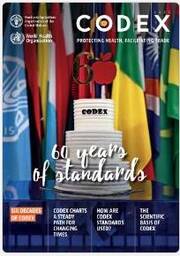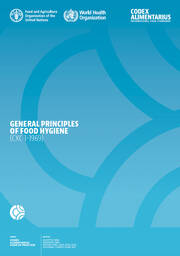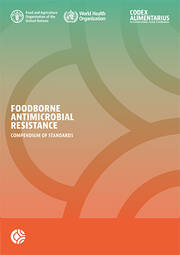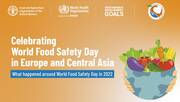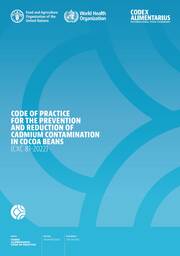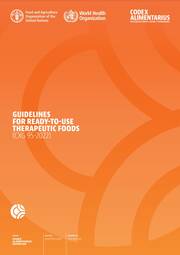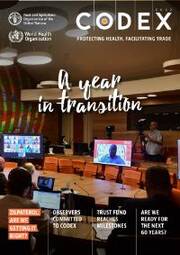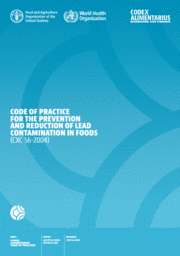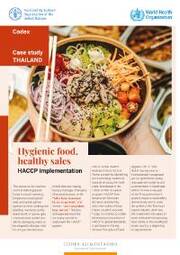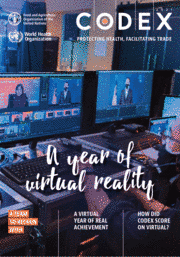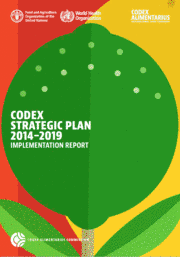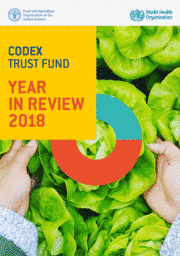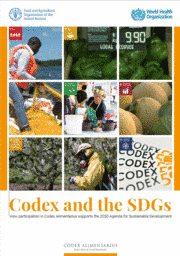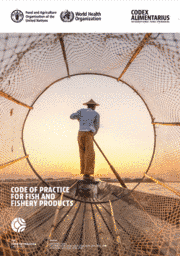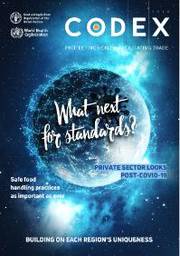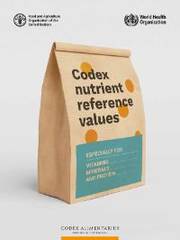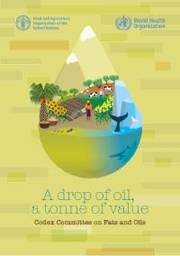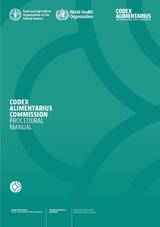主要出版物
The Codex Alimentarius Commission marks its 60th anniversary in 2023. This seventh edition of the CODEX magazine looks back at origins and looks forward to what the future may bring for the international food standard setting. Those involved in Codex, whether they be current or former Commission Chairs, Secretaries, Members or Observers, experts or host secretariats, have contributed to this celebration of Codex achievements. This publication also summarizes the work of the technical and regional committees that have met since the 45th Commission in 2022, bringing new, amended and revised texts for adoption in November 2023. It captures six decades and a year in the life of the Commission and the Codex Secretariat – working to protect health and facilitate trade.
Year: 2023 - Language: English
食典委秘书处每年对所有食典委成员国进行调查,以衡量食典文本的使用情况和影响。秘书处受命通过《2020–2025 年食典委战略计划》监测这一主题,并于2021年与粮农组织和世卫组织评价办公室合作,开始制定一项机制,探讨食典标准的可及性、相关性和可信性等问题。2022年的调查是这项新工作的试行。
2022年食典委调查报告介绍了关于食典文本使用和影响的首次试点调查的结果。调查的重点是以下食典文本:《食品和饲料中污染物和毒素通用标准》、《食品卫生通用原则》、《预包装食品标签通用标准》和《食品添加基本营养素通用原则》。
报告介绍了食典文本的推广、相关性、认可和使用情况,以及最终的影响。报告强调了成员国采用食典文本的障碍,并提出了一系列建议。
Year: 2023 - 其他语言版本: 英语、法语、西班牙语、中文、俄语。
This code of practice has been published in the new format with refreshed design and a DOI (digital object identifier) to monitor downloads and citations.
The General Principles of Food Hygiene is the fundamental Codex document describing the necessary food hygiene measures and food safety controls.
This new revision sees information on the hazard analysis and critical control point (HACCP) system move from an annex into the main body of the document. The update also includes modern concepts not addressed in older versions, including the role of Good Hygiene Practices (GHPs) that require additional attention because they have a greater impact on food safety.
Year: 2023 - Language: English
Antimicrobial resistance (AMR) is a serious global health threat and a food safety issue of primary concern. Governments and international organizations have recognized that the issue has to be approached in a multidisciplinary manner, addressing animal, plant and human health as well as the environment under the One Health approach.
This publication brings together the three Codex texts, two guidelines and a code of practice, that will support governments in designing and running a successful strategy to tackle foodborne AMR.
Year: 2023 - Language: English, French, Spanish, Russian.
This report describes initiatives that were organized by countries in the region for World Food Safety Day in 2022. With over 20 colourful examples from Europe and Central Asia Region, the report also served as a motivator for WFSD in 2023.
Year: 2023 - Language: English
This code of practice has been published in the new format with refreshed design and a DOI (digital object identifier) to monitor downloads and citations.
Cadmium is a heavy metal that predominantly enters the environment through anthropogenic activities such as processing ores, burning fuels, contamination with industrial waste, livestock manure, and use of phosphate fertilizers.
This code of practice provides guidance on recommended practices to prevent and reduce cadmium contamination in cocoa beans before planting, for new or existing cocoa tree plantations and during the production stage through the harvest and post-harvest phases.
Year: 2023 - Language: English
This guideline is another new-look Codex text, which all now include a refreshed design and a DOI (digital object identifier) to monitor downloads and citations.
This publication provides guidance on technical and nutritional aspects of the production of ready-to-use therapeutic foods (RUTF). The provisions of these guidelines apply to RUTF for children aged from 6 to 59 months with severe acute malnutrition (SAM) who need efficacious and timely intervention including safe, palatable foods with a high-energy content and adequate amounts of vitamins, minerals and other nutrients within an appropriately designed programme that promotes continuation of breastfeeding, appropriate transition to nutritious family food and psycho-social support for recovery.
Year: 2023 - Language: English
The CODEX magazine reviews a year in the life of the international food safety standard setting body the Codex Alimentarius Commission. With testimony from the experts who attend technical meetings to set standards and the countries that host those committees, CODEX in 2022 tells the story of another year where operations have been virtual.
Contributions from the parent organizations FAO and WHO combine with insight from Observer organizations and those who operate from within the Codex Secretariat to ensure that once again the Commission will be adopting over 20 new texts this year to ensure food is safe and can be traded fairly.
Year: 2022 - Language: English
This code of practice is a pilot for the update of all Codex texts planned for 2023. New features include a refreshed design and a DOI (digital object identifier) to monitor downloads and citations of Codex texts.
Lead exposure can occur through food and water and lead contamination of food arises from numerous sources, including air, soil and water as well as from food processing, food handling, and food packaging. This code of practice indicates good agricultural and manufacturing practices to minimize lead contamination of foods.
Year: 2022 - Language: English
This case study demonstrates the impact that adoption of science-based food standards can have. When the Thai government adopted into law the Codex General Principles of Food Hygiene (CXC 1-1969), which includes guidelines on the application of the Hygiene Analysis and Critical Control Points system (HACCP) as one of its annexes, it made HACCP non-mandatory, but highly recommended. With support from FAO, the government ensured HACCP training across private companies – especially small businesses, government departments and academia.
Now, after 25 years of work promoting HACCP, the country is reaping the rewards in improved food safety at home and robust and competitive food exports.
Year: 2022 - Language: English
This issue of CODEX tells the story, committee by committee, of the commitment by global experts, host governments and the Codex family of Members and Observer organizations to ensure that the 44th Codex Alimentarius Commission would take place and have over 30 texts to adopt, protecting health and facilitating trade.
In a year of virtual reality it has been the ground-breaking work of all those involved to take meetings online that has ensured continuity throughout the pandemic.
Year: 2021 - Language: English
In 2013 the Codex Alimentarius Commission (CAC) approved its most ambitious plan to date: the Codex Strategic Plan 2014-2019. Structured around four goals, the plan aimed to guide Codex work towards more effective communication and efficient practices that would promote robust, inclusive, transparent and collaborative food standards setting.
This implementation report examines the achievements of the Strategic Plan 2014-2019. It is divided into sections that focus on the plan’s four goals and provides a summary of successes achieved and identifies the challenges that arose.
Year: 2021 - Language: English
The Codex Trust Fund (CTF) supports developing and transition economy countries to participate fully and effectively in Codex.
Exploring 12 country and one group project from around the globe, this publication tells the story of each country’s achievements and successes, as well as the challenges they faced in designing, planning and delivering projects under the Trust Fund.
It also serves as a valuable resource, rich with lessons learned for those countries currently embarking on CTF projects or planning to do so in the future.
Year: 2020 - Language: English
This publication developed by the Codex Trust Fund in collaboration with the Codex Secretariat describes how participation in Codex Alimentarius supports the 2030 Agenda for Sustainable Development
With stories and reports focussing on six SDGs in different countries, readers learn how Codex work supports countries to achieve these particular development goals, which are interconnected with other SDGs and the 2030 Agenda generally.
Codex and the SDGs also highlights how the Codex Trust Fund supports developing and transition economy countries to build food safety capacity, which helps equip them to pursue the SDGs more successfully.
Year: 2020 - Language: English
This updated version of the Code of Practice for Fish and Fishery Products delivers key technical guidance on the harvesting, processing, transport and sale of fish and fishery products and is an essential reference point for both small and large-scale operators.
New guidance developed in the Codex Committee on Food Hygiene is now included in the code, introducing valuable additional information and technical direction on how to minimize the risk of histamine build-up in fish and fishery products at key steps in the food chain from harvesting to processing.
Year: 2020 - Languages: Arabic, Chinese, English, French, Russian and Spanish
Each year this annual report, in a captivating magazine format, records the work of the Codex Alimentarius from one Commission to the next.
Before the COVID-19 pandemic brought a halt to international travel and physical meetings in March 2020, some of the technical committees and all six FAO/WHO Coordinating Committees did meet as planned.
With a special focus on the Codex regions including contributions from Member Countries, the Codex parent organizations and some of the global experts who work with Codex, this 4th edition of the magazine reports on local, regional and global issues effecting food safety and fair practices in food trade.
Year: 2020 - Languages: Arabic, Chinese, English, French, Russian and Spanish
第二届联合国世界食品安全日适逢COVID-19疫情的特殊时刻。纪念活动短则一天,长则通常可达一周或更久,“口罩、微生物细菌和麦克风”成为常态;在这段时间内,个人、家庭、社区、学校、企业和政府机构组织的纪念活动为适应“新常态”而纷纷调整;而在可预见的未来,这种“新常态”仍将影响食品安全和粮食系统。本手册为全球庆祝活动概览,透过该手册,我们可一窥2020年5月和6月期间,全球数百万人参与的网络研讨会、视频、新闻发布会、社论、竞赛、社交媒体帖文、活动资讯等等。
年: 2020 - 语言:英语,法语,西班牙语,阿拉伯语,中文和俄语
This publication explains how Codex and the Committee for Nutrition and Foods for Special Dietary Uses worked over several years to develop the Codex nutrient reference values for protein, 13 vitamins and 6 minerals in the Codex guidelines for nutrition labelling. Nutrient reference values (NRVs) are a set of values used in nutrition labelling derived from authoritative recommendations for daily nutrient intake.
Drawing from primary evidence from several countries, the publication will play a role in informing the general population about healthy eating for the next 10-20 years and forms the basis for establishing a suite of required NRVs for more specific population groups, the first of which are older infants and young children.
Year: 2019 - Language: English
《2020-2025年战略计划》 介绍食典委的使命、愿景、目标、具体 目标和可衡量指标。凸显粮农组织与世卫组织对食品 全和 质量持续重视,指导食典委履行保护消 费者健康和确保公平食品贸易做法的职 责及独特使命。让各成员、政府间 组织、国际非政府组 织及其他利益相关方了解食典委在2020-2025 年期间如何履行职责、满足成员需求(包括 解决新 兴问题)和期望。
年: 2019 - 语言:英语,法语,西班牙语,俄语和中文
2019 has been the year of food safety with The First FAO / WHO / AU International Food Safety Conference in Addis Ababa and the WTO International Forum on Food Safety and Trade in Geneva shining the global spotlight on issues that will affect global food production and supply systems, consumers, industry and the planet itself. The Codex Alimentarius Commission is where the world comes together to set international food safety and quality standards to protect consumer helath and facilitate intenrational trade.
This publication reports on the Codex year and is produced in conjunction with the 42nd Codex Alimentarius Commission held in Geneva 8-12 July 2019.
Year: 2019 - Language: English
Matters of food authenticity are less likely to create problems for public health but they can and do create great damage in the market, leading to breakdowns in consumer confidence and unfair competition as honest traders are unable to match the discounted prices of their fraudulent rivals.
The Codex Committee on Fats and Oils (CCFO) was established in 1964 to elaborate worldwide standards for fats and oils of animal, vegetable and marine origin including margarine and olive oil.
This publication explores how CCFO operates and the role Malaysia has played since taking over the committee from the UK in 2009. With contributions from producing nations, traders, members and observers, the reader will glimpse what goes on in an international standard setting body to ensure safe food and a level playing field for trade.
Year: 2019 - Language: English
In 1964, nine Codex Alimentarius Commission Member countries and a number of Observer organizations gathered in Washington DC, United States of America to begin building consensus on how to produce food hygienically and, where feasible, set limits for microbial counts in foods. Thanks to the visionary approach of Codex in those early years, knowledge about how to safely prepare and handle food was used to develop standards, providing tools for both national regulatory authorities and the food industry to systematically improve food hygiene. The leaps and bounds made over five decades mean that food can now be safely produced, processed and distributed in greater volumes and over greater distances than ever before.
Year: 2019 - Language: English, French, Spanish
The Handbook provides guidance to national officials nominated to serve as chairpersons of subsidiary bodies of the Codex Alimentarius Commission — grouping together in one handy place a range of institutional memory, good practices, rules and useful tools for use as a reference by chairpersons as they prepare for and discharge their duties. The number of committees in the Codex system and the way in which they are chaired had demonstrated the need for such an information product. In the form of a Handbook, it serves as a legacy publication, enshrining as a single resource more than a decade of practical knowledge and experience of senior Secretariat officials and the community of experienced Codex chairpersons.
The Handbook will contribute to: ensuring the effective and equitable participation of Member State officials in Codex work (capacity-development); enhancing communication with stakeholders (communication); and promoting transparency, neutrality and an open, rules-based approach in the conduct of Codex work.
The Handbook is structured to serve as a direct and useful guide for its primary community of users — Codex committee chairpersons — and works hand-in-hand with other resources, guiding chairpersons to participate and build a living community of practice through multiple online resources, such as the Codex Online Commenting System and Codex Chairpersons’ Platform.
Year: 2018 - Language: English
五十多年来,法典文本大力提高了我们所食用食品的安全和质量。《食品法典》 是一本关于全球规则的书,食物链中的每个人都可以跟进,同时它也构成了仍在努力加强本国食品安全监管体系的国家的生命线。
《了解<食品法典>》第五版将使读者能够对食品法典委员会及其运作方法和取得的成果有全面的了解。感兴趣的读者将很快掌握食典系统的结构,深入了解各专业技术委员会以及食典工作的详细程序和过程。
出版年份: 2018 - 语言:英语,中文和俄语
在新的出版物《贸易与食品标准》中,联合国粮农组织(FAO)和世界贸易组织(WTO) 对如何制定和使用国际食品标准做了简单解释。协调标准的目标是保护公共健康,减少食品生产者的合规障碍,并将代价高昂的贸易中断风险最小化。
出版年份: 2017 - 语种: 英文
《食品标准的科学》展现了国际食品法典委员会从2016年7月(CAC39)到2017年7月(CAC40)在向大家提供安全优质食品的道路上所做出的努力。在这一年中,12个技术委员会和6个区域委员会召开会议,讨论修订国际食品标准、导则和操作规范。作为国际食品标准管理机构,国际食品法典委员会(CAC)在每年7月的大会中对其分委员会的提案做出决定。《食品标准的科学——第39到40届国际食品法典委员会》通过杂志风格的文章编排,与读者分享来自不同合作者的观点和贡献,包括食典187个成员国与1个成员组织(欧盟),以及200多个观察员。
出版年份:2017 - 语种:英语
食品法典委员会憧憬全世界消费者能够享有可能实现的最高水平的保护,包括食品安全和质量方面的保护。为此,食典委将制定国际认可的标准和有关文本,用于国内管理和国际食品贸易,这些标准和文本将以科学原则为基础并实现保护消费者健康和确保公平的食品贸易实践的目标。
年: 2014 - 語言: 中文
The Procedural Manual of the Codex Alimentarius Commission sets out the basic Rules of Procedure, procedures for the elaboration of Codex standards and related texts, basic definitions and guidelines for the operation of Codex committees.
This edition incorporates the new layout of Codex texts. It also amends the section on commodity standards dealing with non-retail containers; introduces text on working by correspondence and presents a new annex on extrapolation of maximum residue limits of veterinary drugs.



